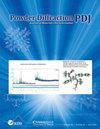宁替尼酯半水合物(C31H33N5O4)(C2H5O3S)(H2O)0.5的粉末 X 射线衍射
IF 0.4
4区 材料科学
Q4 MATERIALS SCIENCE, CHARACTERIZATION & TESTING
引用次数: 0
摘要
利用同步辐射 X 射线粉末衍射数据完善了宁替尼酯半水合物的晶体结构,并利用密度泛函理论技术对其进行了优化。在 295 K 时,该晶体结构中的氢键非常突出。水分子与其中一个酯阴离子形成两个中等强度的 O-H⋯O 氢键。每个阳离子中质子化的氮原子与一个酯阴离子形成一个 N-H⋯O 氢键。环状 N-H 基团与羰基形成强分子内 N-H⋯O 氢键。环 N-H 基团与酯阴离子形成分子内 N-H⋯O 氢键。存在许多以芳香族 C-H、亚甲基和甲基为供体的 C-H⋅⋅O 氢键(和一个 C-H⋯N 氢键)。两种阳离子的氢键模式差别很大。该粉末图样已提交给 ICDD,以便纳入粉末衍射文件™ (PDF®) 中。本文章由计算机程序翻译,如有差异,请以英文原文为准。
Powder X-ray diffraction of nintedanib esylate hemihydrate, (C31H33N5O4)(C2H5O3S)(H2O)0.5
The crystal structure of nintedanib esylate hemihydrate was refined using synchrotron X-ray powder diffraction data and optimized using density functional theory techniques. Nintedanib esylate hemihydrate crystallizes in space group P-1 (#2) with a = 11.5137(1), b = 16.3208(4), c = 19.1780(5) Å, α = 69.0259(12), β = 84.4955(8), γ = 89.8319(6)°, V = 3347.57(3) Å3 , and Z = 4 at 295 K. Hydrogen bonds are prominent in the crystal structure. The water molecule forms two medium-strength O–H⋯O hydrogen bonds to one of the esylate anions. The protonated nitrogen atom in each cation forms a N–H⋯O hydrogen bond to an esylate anion. The ring N–H groups form strong intramolecular N–H⋯O hydrogen bonds to carbonyl groups. The ring N–H groups form intramolecular N–H⋯O hydrogen bonds to esylate anions. Many C–H⋅⋅⋅O hydrogen bonds (and one C–H⋯N hydrogen bond), with aromatic C–H, methylene groups and methyl groups as donors, are present. The hydrogen bonding patterns of the two cations differ considerably. The powder pattern has been submitted to ICDD for inclusion in the Powder Diffraction File™ (PDF®)
求助全文
通过发布文献求助,成功后即可免费获取论文全文。
去求助
来源期刊

Powder Diffraction
工程技术-材料科学:表征与测试
CiteScore
0.90
自引率
0.00%
发文量
50
审稿时长
>12 weeks
期刊介绍:
Powder Diffraction is a quarterly journal publishing articles, both experimental and theoretical, on the use of powder diffraction and related techniques for the characterization of crystalline materials. It is published by Cambridge University Press (CUP) for the International Centre for Diffraction Data (ICDD).
 求助内容:
求助内容: 应助结果提醒方式:
应助结果提醒方式:


